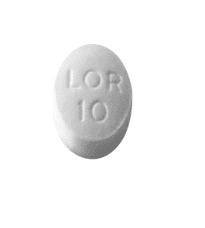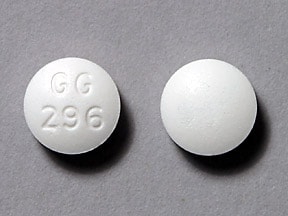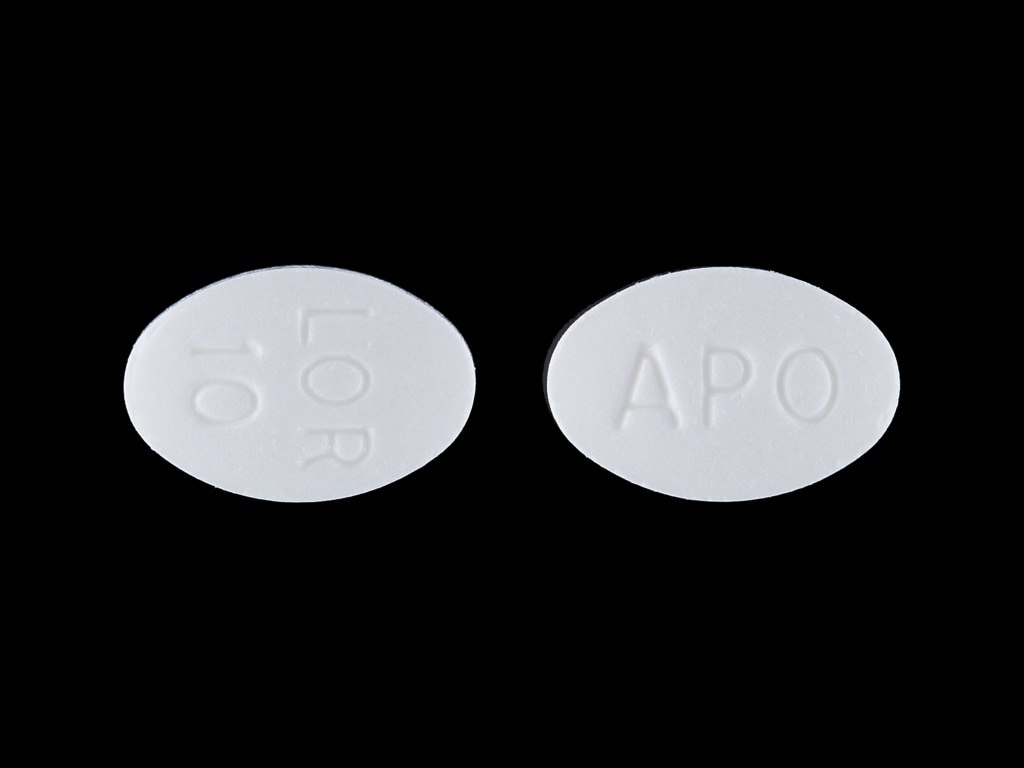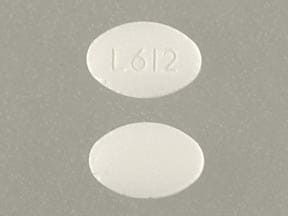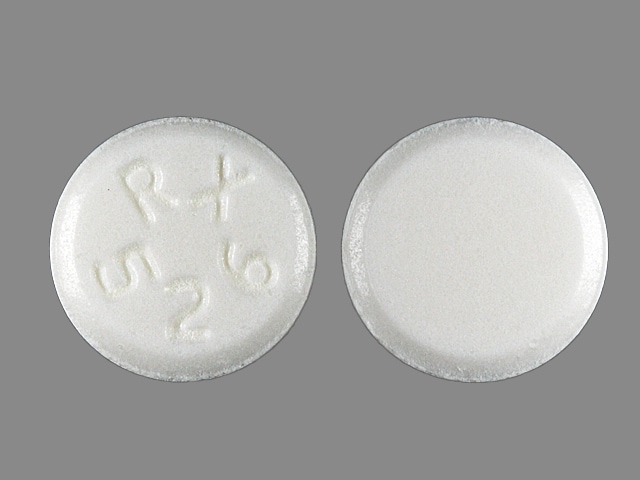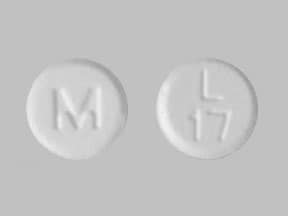Dosage Forms
Excipient information presented when available (limited, particularly for generics); consult specific product labeling. [DSC] = Discontinued product
Capsule, Oral:
Claritin: 10 mg [contains brilliant blue fcf (fd&c blue #1)]
GoodSense Allergy Relief: 10 mg [contains brilliant blue fcf (fd&c blue #1)]
Generic: 10 mg
Solution, Oral:
Childrens Loratadine: 5 mg/5 mL (120 mL) [alcohol free, dye free, sugar free; contains propylene glycol, sodium benzoate; grape flavor]
Loratadine Childrens: 5 mg/5 mL (120 mL [DSC]) [alcohol free, dye free, sugar free; contains polyethylene glycol, propylene glycol, sodium benzoate; grape flavor]
Loratadine Childrens: 5 mg/5 mL (120 mL [DSC]) [alcohol free, dye free, sugar free; contains propylene glycol, sodium benzoate; fruit flavor]
Loratadine Hives Relief: 5 mg/5 mL (120 mL [DSC]) [alcohol free, dye free, sugar free; contains propylene glycol, sodium benzoate; grape flavor]
Syrup, Oral:
Childrens Loratadine: 5 mg/5 mL (120 mL) [fruit flavor]
Childrens Loratadine: 5 mg/5 mL (120 mL) [alcohol free, dye free; contains propylene glycol, sodium benzoate, sodium metabisulfite; grape flavor]
Claritin: 5 mg/5 mL (60 mL [DSC], 120 mL [DSC], 150 mL [DSC]) [alcohol free, color free, dye free, sugar free; contains edetate disodium, propylene glycol, sodium benzoate; grape flavor]
Claritin Allergy Childrens: 5 mg/5 mL (240 mL) [alcohol free, dye free, sugar free; contains edetate disodium, propylene glycol, sodium benzoate, sorbitol]
Loratadine Childrens: 5 mg/5 mL (120 mL) [alcohol free, dye free, gluten free, sugar free; contains edetate disodium, propylene glycol, sodium benzoate; grape flavor]
Loratadine Childrens: 5 mg/5 mL (10 mL) [alcohol free, dye free, sugar free; contains propylene glycol, sodium benzoate; grape flavor]
Loratadine Childrens: 5 mg/5 mL (120 mL) [sugar free; contains polyethylene glycol, propylene glycol, sodium benzoate, sodium metabisulfite; grape flavor]
Tablet, Oral:
Allergy: 10 mg
Allergy Non-Drowsy: 10 mg [DSC]
Allergy Relief: 10 mg
Allergy Relief: 10 mg [contains corn starch]
Allergy Relief: 10 mg [gluten free]
Allergy Relief Loratadine: 10 mg
Claritin: 10 mg
Loradamed: 10 mg
Generic: 10 mg
Tablet Chewable, Oral:
Claritin: 5 mg [contains aspartame, fd&c blue #2 aluminum lake; grape flavor]
Claritin Childrens: 5 mg [contains aspartame]
Loratadine Childrens: 5 mg [DSC] [contains aspartame; bubble-gum flavor]
Tablet Disintegrating, Oral:
Alavert: 10 mg [contains aspartame]
Alavert: 10 mg [contains aspartame; citrus flavor]
Allergy Relief: 10 mg [DSC] [contains aspartame]
Claritin Reditabs: 5 mg, 10 mg
Triaminic Allerchews: 10 mg
Pharmacology
Mechanism of Action
Long-acting tricyclic antihistamine with selective peripheral histamine H1-receptor antagonistic properties
Pharmacokinetics/Pharmacodynamics
Absorption
Rapid
Distribution
Vd: 119 L/kg (Haria 1994); binds preferentially to peripheral nervous system H1 receptors; no appreciable entry into CNS (Claritin prescribing information 2000)
Metabolism
Extensively hepatic via CYP2D6 and 3A4 to active metabolite (descarboethoxyloratadine) (Claritin prescribing information 2000)
Excretion
Urine (40%) and feces (40%) as metabolites
Onset of Action
1-3 hours; Peak effect: 8-12 hours
Time to Peak
Loratadine: 1.3 hours (loratadine), 2.3 hours (metabolite) (Claritin prescribing information 2000)
Duration of Action
>24 hours
Half-Life Elimination
8.4 hours (range: 3 to 20 hours) (loratadine), 28 hours (range: 8.8 to 92 hours) (metabolite) (Claritin prescribing information 2000); hepatic impairment: 24 hours (loratadine), 37 hours (metabolite) (Claritin prescribing information 2000)
Protein Binding
97% to 99% (loratadine), 73% to 76% (metabolite) (Haria 1994)
Use in Specific Populations
Special Populations: Renal Function Impairment
With CrCl less than 30 mL/min, AUC and Cmax are increased approximately 73% for loratadine and 120% for its metabolite.
Special Populations: Hepatic Function Impairment
AUC and Cmax doubled for loratadine
Special Populations: Elderly
AUC and Cmax are increased approximately 50%, and t½ ranged from 6.7 to 37 h.
Use: Labeled Indications
Allergic rhinitis or conjunctivitis: Relief of nasal and non-nasal symptoms of seasonal allergies.
OTC labeling: Patient-guided therapy for symptoms of hay fever or other upper respiratory allergies.
Urticaria: Treatment of itching due to hives (urticaria).
Contraindications
Hypersensitivity to loratadine or any component of the formulation
Dosage and Administration
Dosing: Adult
Allergic rhinitis or conjunctivitis: Oral: 10 mg once daily or 5 mg twice daily.
OTC labeling (patient-guided therapy for symptoms of hay fever or other upper respiratory allergies): Oral: 10 mg once daily or 5 mg twice daily; maximum dose: 10 mg/day.
Urticaria (acute and chronic spontaneous): Oral: Initial: 10 mg once daily. If symptom control is inadequate, may increase to 10 mg twice daily. There is limited evidence for larger doses. Reevaluate necessity for continued treatment periodically (Asero 2019; Khan 2019; Zuberbier 2018).
Dosing: Geriatric
Refer to adult dosing.
Dosing: Pediatric
Allergic symptoms/rhinitis: Oral
Children 2 to <6 years: Oral liquid or chewable tablet: 5 mg once daily
Children ≥6 years and Adolescents:
Oral liquid, capsule, tablet, or chewable tablet: 10 mg once daily
Dispersible tablet: 5 mg twice daily or 10 mg once daily
Chronic idiopathic urticaria: Limited data available (Kliegman 2011; Simons 1994):
Children 2 to 12 years: 5 mg once daily
Adolescents: 10 mg once daily
Administration
May be administered without regard to meals.
Dispersible tablet: Place in mouth and allow to dissolve. Swallow with or without water.
Dietary Considerations
May be taken without regard to meals. Some products may contain phenylalanine and/or sodium.
Storage
Store at 20°C to 25°C (68°F to 77°F).
Rapidly-disintegrating tablets: Use within 6 months of opening foil pouch, and immediately after opening individual tablet blister. Store in a dry place.
Loratadine Images
Drug Interactions
Acetylcholinesterase Inhibitors: May diminish the therapeutic effect of Anticholinergic Agents. Anticholinergic Agents may diminish the therapeutic effect of Acetylcholinesterase Inhibitors. Monitor therapy
Aclidinium: May enhance the anticholinergic effect of Anticholinergic Agents. Avoid combination
Alcohol (Ethyl): CNS Depressants may enhance the CNS depressant effect of Alcohol (Ethyl). Monitor therapy
Alizapride: May enhance the CNS depressant effect of CNS Depressants. Monitor therapy
Amantadine: May enhance the anticholinergic effect of Anticholinergic Agents. Monitor therapy
Amezinium: Antihistamines may enhance the stimulatory effect of Amezinium. Monitor therapy
Amiodarone: May increase the serum concentration of Loratadine. Management: Due to reported QT interval prolongation and Torsades de Pointes with this combination, consider an alternative to loratadine when possible. Consider therapy modification
Amphetamines: May diminish the sedative effect of Antihistamines. Monitor therapy
Anticholinergic Agents: May enhance the adverse/toxic effect of other Anticholinergic Agents. Monitor therapy
Azelastine (Nasal): CNS Depressants may enhance the CNS depressant effect of Azelastine (Nasal). Avoid combination
Benzylpenicilloyl Polylysine: Antihistamines may diminish the diagnostic effect of Benzylpenicilloyl Polylysine. Management: Suspend systemic H1 antagonists for benzylpenicilloyl-polylysine skin testing and delay testing until systemic antihistaminic effects have dissipated. A histamine skin test may be used to assess persistent antihistaminic effects. Consider therapy modification
Betahistine: Antihistamines may diminish the therapeutic effect of Betahistine. Monitor therapy
Blonanserin: CNS Depressants may enhance the CNS depressant effect of Blonanserin. Consider therapy modification
Botulinum Toxin-Containing Products: May enhance the anticholinergic effect of Anticholinergic Agents. Monitor therapy
Brexanolone: CNS Depressants may enhance the CNS depressant effect of Brexanolone. Monitor therapy
Brimonidine (Topical): May enhance the CNS depressant effect of CNS Depressants. Monitor therapy
Bromopride: May enhance the CNS depressant effect of CNS Depressants. Monitor therapy
Bromperidol: May enhance the CNS depressant effect of CNS Depressants. Avoid combination
Buprenorphine: CNS Depressants may enhance the CNS depressant effect of Buprenorphine. Management: Consider reduced doses of other CNS depressants, and avoiding such drugs in patients at high risk of buprenorphine overuse/self-injection. Initiate buprenorphine at lower doses in patients already receiving CNS depressants. Consider therapy modification
Cannabidiol: May enhance the CNS depressant effect of CNS Depressants. Monitor therapy
Cannabis: May enhance the CNS depressant effect of CNS Depressants. Monitor therapy
Chloral Betaine: May enhance the adverse/toxic effect of Anticholinergic Agents. Monitor therapy
Chlormethiazole: May enhance the CNS depressant effect of CNS Depressants. Management: Monitor closely for evidence of excessive CNS depression. The chlormethiazole labeling states that an appropriately reduced dose should be used if such a combination must be used. Consider therapy modification
Chlorphenesin Carbamate: May enhance the adverse/toxic effect of CNS Depressants. Monitor therapy
Cimetropium: Anticholinergic Agents may enhance the anticholinergic effect of Cimetropium. Avoid combination
CNS Depressants: May enhance the adverse/toxic effect of other CNS Depressants. Monitor therapy
Dimethindene (Topical): May enhance the CNS depressant effect of CNS Depressants. Monitor therapy
Doxylamine: May enhance the CNS depressant effect of CNS Depressants. Management: The manufacturer of Diclegis (doxylamine/pyridoxine), intended for use in pregnancy, specifically states that use with other CNS depressants is not recommended. Monitor therapy
Dronabinol: May enhance the CNS depressant effect of CNS Depressants. Monitor therapy
Droperidol: May enhance the CNS depressant effect of CNS Depressants. Management: Consider dose reductions of droperidol or of other CNS agents (eg, opioids, barbiturates) with concomitant use. Exceptions to this monograph are discussed in further detail in separate drug interaction monographs. Consider therapy modification
Eluxadoline: Anticholinergic Agents may enhance the constipating effect of Eluxadoline. Avoid combination
Erdafitinib: May increase the serum concentration of P-glycoprotein/ABCB1 Substrates. Monitor therapy
Esketamine: May enhance the CNS depressant effect of CNS Depressants. Monitor therapy
Flunitrazepam: CNS Depressants may enhance the CNS depressant effect of Flunitrazepam. Consider therapy modification
Gastrointestinal Agents (Prokinetic): Anticholinergic Agents may diminish the therapeutic effect of Gastrointestinal Agents (Prokinetic). Monitor therapy
Glucagon: Anticholinergic Agents may enhance the adverse/toxic effect of Glucagon. Specifically, the risk of gastrointestinal adverse effects may be increased. Monitor therapy
Glycopyrrolate (Oral Inhalation): Anticholinergic Agents may enhance the anticholinergic effect of Glycopyrrolate (Oral Inhalation). Avoid combination
Glycopyrronium (Topical): May enhance the anticholinergic effect of Anticholinergic Agents. Avoid combination
Hyaluronidase: Antihistamines may diminish the therapeutic effect of Hyaluronidase. Management: Patients receiving antihistamines (particularly at larger doses) may not experience the desired clinical response to standard doses of hyaluronidase. Larger doses of hyaluronidase may be required. Consider therapy modification
HYDROcodone: CNS Depressants may enhance the CNS depressant effect of HYDROcodone. Management: Avoid concomitant use of hydrocodone and benzodiazepines or other CNS depressants when possible. These agents should only be combined if alternative treatment options are inadequate. If combined, limit the dosages and duration of each drug. Consider therapy modification
HydrOXYzine: May enhance the CNS depressant effect of CNS Depressants. Monitor therapy
Ipratropium (Oral Inhalation): May enhance the anticholinergic effect of Anticholinergic Agents. Avoid combination
Itopride: Anticholinergic Agents may diminish the therapeutic effect of Itopride. Monitor therapy
Kava Kava: May enhance the adverse/toxic effect of CNS Depressants. Monitor therapy
Lasmiditan: May increase the serum concentration of P-glycoprotein/ABCB1 Substrates. Avoid combination
Lemborexant: May enhance the CNS depressant effect of CNS Depressants. Management: Dosage adjustments of lemborexant and of concomitant CNS depressants may be necessary when administered together because of potentially additive CNS depressant effects. Close monitoring for CNS depressant effects is necessary. Consider therapy modification
Levosulpiride: Anticholinergic Agents may diminish the therapeutic effect of Levosulpiride. Avoid combination
Lofexidine: May enhance the CNS depressant effect of CNS Depressants. Management: Drugs listed as exceptions to this monograph are discussed in further detail in separate drug interaction monographs. Monitor therapy
Lumacaftor and Ivacaftor: May decrease the serum concentration of P-glycoprotein/ABCB1 Substrates. Lumacaftor and Ivacaftor may increase the serum concentration of P-glycoprotein/ABCB1 Substrates. Monitor therapy
Magnesium Sulfate: May enhance the CNS depressant effect of CNS Depressants. Monitor therapy
Methotrimeprazine: CNS Depressants may enhance the CNS depressant effect of Methotrimeprazine. Methotrimeprazine may enhance the CNS depressant effect of CNS Depressants. Management: Reduce adult dose of CNS depressant agents by 50% with initiation of concomitant methotrimeprazine therapy. Further CNS depressant dosage adjustments should be initiated only after clinically effective methotrimeprazine dose is established. Consider therapy modification
MetyroSINE: CNS Depressants may enhance the sedative effect of MetyroSINE. Monitor therapy
Mianserin: May enhance the anticholinergic effect of Anticholinergic Agents. Monitor therapy
Minocycline (Systemic): May enhance the CNS depressant effect of CNS Depressants. Monitor therapy
Mirabegron: Anticholinergic Agents may enhance the adverse/toxic effect of Mirabegron. Monitor therapy
Nabilone: May enhance the CNS depressant effect of CNS Depressants. Monitor therapy
Nitroglycerin: Anticholinergic Agents may decrease the absorption of Nitroglycerin. Specifically, anticholinergic agents may decrease the dissolution of sublingual nitroglycerin tablets, possibly impairing or slowing nitroglycerin absorption. Monitor therapy
Opioid Agonists: CNS Depressants may enhance the CNS depressant effect of Opioid Agonists. Management: Avoid concomitant use of opioid agonists and benzodiazepines or other CNS depressants when possible. These agents should only be combined if alternative treatment options are inadequate. If combined, limit the dosages and duration of each drug. Consider therapy modification
Orphenadrine: CNS Depressants may enhance the CNS depressant effect of Orphenadrine. Avoid combination
Oxatomide: May enhance the anticholinergic effect of Anticholinergic Agents. Avoid combination
Oxomemazine: May enhance the CNS depressant effect of CNS Depressants. Avoid combination
OxyCODONE: CNS Depressants may enhance the CNS depressant effect of OxyCODONE. Management: Avoid concomitant use of oxycodone and benzodiazepines or other CNS depressants when possible. These agents should only be combined if alternative treatment options are inadequate. If combined, limit the dosages and duration of each drug. Consider therapy modification
Paraldehyde: CNS Depressants may enhance the CNS depressant effect of Paraldehyde. Avoid combination
Perampanel: May enhance the CNS depressant effect of CNS Depressants. Management: Patients taking perampanel with any other drug that has CNS depressant activities should avoid complex and high-risk activities, particularly those such as driving that require alertness and coordination, until they have experience using the combination. Consider therapy modification
P-glycoprotein/ABCB1 Inducers: May decrease the serum concentration of P-glycoprotein/ABCB1 Substrates. P-glycoprotein inducers may also further limit the distribution of p-glycoprotein substrates to specific cells/tissues/organs where p-glycoprotein is present in large amounts (e.g., brain, T-lymphocytes, testes, etc.). Monitor therapy
P-glycoprotein/ABCB1 Inhibitors: May increase the serum concentration of P-glycoprotein/ABCB1 Substrates. P-glycoprotein inhibitors may also enhance the distribution of p-glycoprotein substrates to specific cells/tissues/organs where p-glycoprotein is present in large amounts (e.g., brain, T-lymphocytes, testes, etc.). Monitor therapy
Piribedil: CNS Depressants may enhance the CNS depressant effect of Piribedil. Monitor therapy
Pitolisant: Antihistamines may diminish the therapeutic effect of Pitolisant. Avoid combination
Potassium Chloride: Anticholinergic Agents may enhance the ulcerogenic effect of Potassium Chloride. Management: Patients on drugs with substantial anticholinergic effects should avoid using any solid oral dosage form of potassium chloride. Avoid combination
Potassium Citrate: Anticholinergic Agents may enhance the ulcerogenic effect of Potassium Citrate. Avoid combination
Pramipexole: CNS Depressants may enhance the sedative effect of Pramipexole. Monitor therapy
Pramlintide: May enhance the anticholinergic effect of Anticholinergic Agents. These effects are specific to the GI tract. Consider therapy modification
Ramosetron: Anticholinergic Agents may enhance the constipating effect of Ramosetron. Monitor therapy
Ranolazine: May increase the serum concentration of P-glycoprotein/ABCB1 Substrates. Monitor therapy
Revefenacin: Anticholinergic Agents may enhance the anticholinergic effect of Revefenacin. Avoid combination
ROPINIRole: CNS Depressants may enhance the sedative effect of ROPINIRole. Monitor therapy
Rotigotine: CNS Depressants may enhance the sedative effect of Rotigotine. Monitor therapy
Rufinamide: May enhance the adverse/toxic effect of CNS Depressants. Specifically, sleepiness and dizziness may be enhanced. Monitor therapy
Secretin: Anticholinergic Agents may diminish the therapeutic effect of Secretin. Management: Avoid concomitant use of anticholinergic agents and secretin. Discontinue anticholinergic agents at least 5 half-lives prior to administration of secretin. Consider therapy modification
Selective Serotonin Reuptake Inhibitors: CNS Depressants may enhance the adverse/toxic effect of Selective Serotonin Reuptake Inhibitors. Specifically, the risk of psychomotor impairment may be enhanced. Monitor therapy
Sodium Oxybate: May enhance the CNS depressant effect of CNS Depressants. Management: Consider alternatives to combined use. When combined use is needed, consider minimizing doses of one or more drugs. Use of sodium oxybate with alcohol or sedative hypnotics is contraindicated. Consider therapy modification
Suvorexant: CNS Depressants may enhance the CNS depressant effect of Suvorexant. Management: Dose reduction of suvorexant and/or any other CNS depressant may be necessary. Use of suvorexant with alcohol is not recommended, and the use of suvorexant with any other drug to treat insomnia is not recommended. Consider therapy modification
Tapentadol: May enhance the CNS depressant effect of CNS Depressants. Management: Avoid concomitant use of tapentadol and benzodiazepines or other CNS depressants when possible. These agents should only be combined if alternative treatment options are inadequate. If combined, limit the dosages and duration of each drug. Consider therapy modification
Tetrahydrocannabinol: May enhance the CNS depressant effect of CNS Depressants. Monitor therapy
Tetrahydrocannabinol and Cannabidiol: May enhance the CNS depressant effect of CNS Depressants. Monitor therapy
Thalidomide: CNS Depressants may enhance the CNS depressant effect of Thalidomide. Avoid combination
Thiazide and Thiazide-Like Diuretics: Anticholinergic Agents may increase the serum concentration of Thiazide and Thiazide-Like Diuretics. Monitor therapy
Tiotropium: Anticholinergic Agents may enhance the anticholinergic effect of Tiotropium. Avoid combination
Topiramate: Anticholinergic Agents may enhance the adverse/toxic effect of Topiramate. Monitor therapy
Trimeprazine: May enhance the CNS depressant effect of CNS Depressants. Monitor therapy
Umeclidinium: May enhance the anticholinergic effect of Anticholinergic Agents. Avoid combination
Zolpidem: CNS Depressants may enhance the CNS depressant effect of Zolpidem. Management: Reduce the Intermezzo brand sublingual zolpidem adult dose to 1.75 mg for men who are also receiving other CNS depressants. No such dose change is recommended for women. Avoid use with other CNS depressants at bedtime; avoid use with alcohol. Consider therapy modification
Test Interactions
May suppress the wheal and flare reactions to skin test antigens
Adverse Reactions
1% to 10%:
Central nervous system: Headache (adults: 8%), sedated state (adults: 8%), drowsiness (adults: 4%), fatigue (adults: 4%), nervousness (children: 4%)
Gastrointestinal: Xerostomia (adults: 2% to 4%), abdominal pain (children: 2%), vomiting (children: 2%), diarrhea (children: 1%)
Neuromuscular & skeletal: Hyperkinetic muscle activity (children: 3%)
Frequency not defined:
Dermatologic: Skin rash (adults)
Gastrointestinal: Gastritis (adults), nausea (adults)
Hypersensitivity: Hypersensitivity reaction (adults)
<1%, postmarketing, and/or case reports: Alopecia, anaphylaxis, cough, dizziness, dry nose, hepatic insufficiency, increased appetite, palpitations, seizure, tachycardia
Warnings/Precautions
Disease-related concerns:
- Hepatic impairment: Hepatic impairment increases systemic exposure. Use with caution.
- Renal impairment: Use with caution in patients with renal impairment.
Concurrent drug therapy issues:
- Sedatives: Effects may be potentiated when used with other sedative drugs or ethanol.
Dosage form specific issues:
- Benzyl alcohol and derivatives: Some dosage forms may contain sodium benzoate/benzoic acid; benzoic acid (benzoate) is a metabolite of benzyl alcohol; large amounts of benzyl alcohol (≥99 mg/kg/day) have been associated with a potentially fatal toxicity (“gasping syndrome”) in neonates; the “gasping syndrome” consists of metabolic acidosis, respiratory distress, gasping respirations, CNS dysfunction (including convulsions, intracranial hemorrhage), hypotension, and cardiovascular collapse (AAP ["Inactive" 1997]; CDC, 1982); some data suggests that benzoate displaces bilirubin from protein binding sites (Ahlfors, 2001); avoid or use dosage forms containing benzyl alcohol derivative with caution in neonates. See manufacturer’s labeling.
- Phenylalanine: Some products may contain phenylalanine.
Pregnancy
Pregnancy Considerations
Guidelines for the use of antihistamines in the treatment of allergic rhinitis or urticaria in pregnancy are generally the same as in nonpregnant females. Loratadine may be used when a second generation antihistamine is needed. The lowest effective dose should be used (Powell 2015; Scadding 2017; Wallace 2008; Zuberbier 2018).
Patient Education
What is this drug used for?
- It is used to ease allergy signs.
- It is used to treat hives.
Frequently reported side effects of this drug
- Headache
- Fatigue
Other side effects of this drug: Talk with your doctor right away if you have any of these signs of:
- Severe loss of strength and energy
- Signs of a significant reaction like wheezing; chest tightness; fever; itching; bad cough; blue skin color; seizures; or swelling of face, lips, tongue, or throat.
Note: This is not a comprehensive list of all side effects. Talk to your doctor if you have questions.
Consumer Information Use and Disclaimer: This information should not be used to decide whether or not to take this medicine or any other medicine. Only the healthcare provider has the knowledge and training to decide which medicines are right for a specific patient. This information does not endorse any medicine as safe, effective, or approved for treating any patient or health condition. This is only a brief summary of general information about this medicine. It does NOT include all information about the possible uses, directions, warnings, precautions, interactions, adverse effects, or risks that may apply to this medicine. This information is not specific medical advice and does not replace information you receive from the healthcare provider. You must talk with the healthcare provider for complete information about the risks and benefits of using this medicine.
